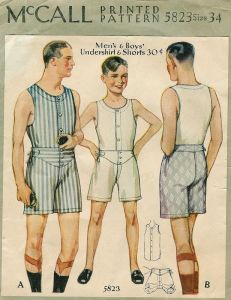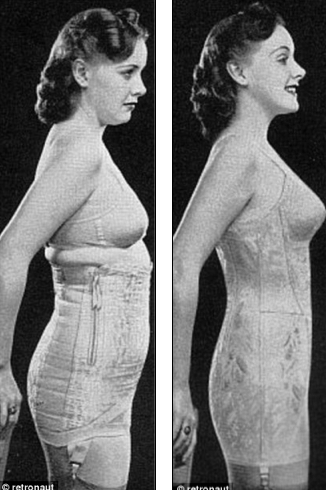If you’re a fan of true vintage clothing, chances are at some point or another you’ve tried something on, and even if it fits, thought “something isn’t right…“
Chances are, the thing you’re lacking is the right underclothes.
Vintage women’s clothing was made with the assumption that you were wearing specific garments underneath – chances are this included a corset or girdle. While the styles changed with the decades, the desire to shape the female form into something it was not stayed fairly consistent through the 20th century (and before). You can read about the changing styles in our previous post, here.
The same can be said, though to a far lesser extent, about men’s clothing. If you’ve ever tried to put on a pair of vintage trousers over some baggy boxers, you’ll know what I mean. Similarly, a lot of shirts look strange without an undershirt underneath as their fabric is too transparent, and even then it is clear they assumed you’d wear a jacket or blazer, otherwise the outline of the undershirt is clearly seen.

When we did The Rear Window back in 2019, we visited Gigi’s House of Frills to learn all about vintage underthings, and I can tell you the difference to silhouette is incredible. While the dresses already looked lovely on our actors, the addition of a bullet bra and girdle stepped it up to Hollywood glam levels.
There are many places in the city and online where you can find authentic vintage lingerie, but I highly recommend your first stop be Gigi’s. She is not only lovely and knowledgeable, she carries the widest range of sizes I have ever seen for underwear and lingerie. If she doesn’t have true vintage in your size she will have a modern alternative that is sure to work.



When it comes to buying vintage lingerie, there’s a few quick tips I would share to make the process go smoothly;
- Sizes Change: sizing hasn’t always been standardized, and when looking at vintage patterns or clothes sometimes the number can be a bit of a shock to your system because you’re judging it by the sizes we use today. If you can’t try something on, make sure to at least read the measurements and not assume that the number listed will give you an accurate idea of fit. For example, this helpful article explains how someone who was a size 14 in 1937 would be a size 8 in 1967 and a 0 today.
- Most People Were Shorter: we tend to think that everyone was smaller “back in the day”, but that’s not really true. Just as slim men and women today get more representation in the media and in stores, the same could be said for the 1920s, 40s, 50s etc. So while data suggests that there are more overweight people now than there were then, that isn’t to say that everyone was super tiny like the actors we picture from golden age Hollywood. Rather, the materials we have left today are more likely to be what was most produced then, and so it’s easier to find pictures of slim people, and clothing in smaller sizes. It’s really a numbers game. What has increased across the board (in Canada at least) is people’s average height. This means when you are shopping for vintage stockings or girdles, if you’re on the taller side (as I am), it can be hard to find something with the right fit. I often find my torso is a bit too long for pieces I would otherwise be able to fit. I don’t have any great advice for this other than to just remind yourself that there’s nothing wrong with you if you’re having trouble finding something that works, it was just made for someone at a very different time.
- Fabrics Were Different: those of you old enough to remember the days before lycra in jeans will have an easier time with the unmovable, unforgiving fabrics from days of yore, but today most clothing is made with so much stretch we don’t have to give much thought to the fit provided it is in our size. Compared to Spanx, vintage girdles can feel like a bit of a torture device, but when you get used to getting them on and off many people find the fit not at all uncomfortable, and I think they do a FAR better job at shaping, if that’s what you’re going for. If you’re new to vintage shape wear go for something that is adjustable, whether with lacing or multiple hooks, as even something that “fits” can be a bit extreme for someone new to the game. And if you see something that says it was “cut on the bias”, that’s a good thing. That’s the old-timey way of making something have a bit of give, and is the closest you’ll find to stretchy material in a lot of vintage wear.
So there you have it! A quick rundown on vintage underclothes. They’re fun, they’re glamourous, and they’re sustainable because as we always say, the most sustainable item is the one that already exists. So shop vintage.

